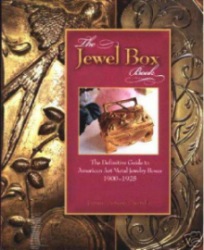by Joanne
Wiertella
(click on photos to enlarge image)
ANTIQUE JEWEL BOXES AS SOUVENIRS
AMERICAN AND GERMAN
With the advent of the Industrial Revolution,
developments in metals production and the concept of
mass production were adopted in America and Europe
by the late 19th century. In the early 1900's metal
objects, like jewelry boxes, and other novelties, could be
manufactured in quantity-far less costly to produce than
the one-on items created by craftsmen previously
available only to the wealthy.
International trade between countries had brought
attention to new decorative styles from all over the
world. The Industrial Revolution also encouraged the
development of a middle class which was now also able to
purchase not just the essentials, but also to travel to
points of interest and purchase decorative items.
To profit from these changes in traveling, American
entrepreneurs created the “Exposition”--a trade fair
with the primary purpose of providing an opportunity for
advertising products and exchanging scientific, cultural
and industrial ideas. These Fairs were very popular
tourist destinations, providing a "world view" never
before imagined, and spurring an interest in and
enthusiasm for collecting.
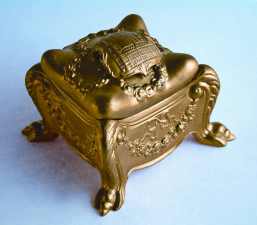 |
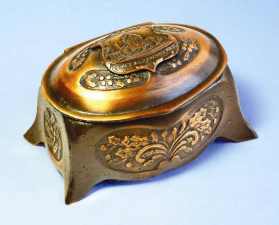 |
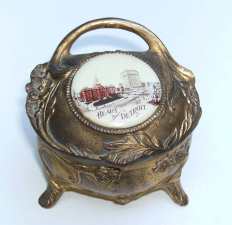 |
Kronheimer & Oldenbusch
Attached shield; City Hall,
Milwaukee, Wisconsin
|
Kronheimer & Oldenbusch
Attached shield; Iron Mine,
Calumet, Michigan
|
Brainard & Wilson
Painted ceramic disc;
Detroit, Michigan
|
Called "jewel cases", "caskets" and occasionally "trinket
boxes", early jewelry boxes in the United States were
primarily of the popular Art Nouveau style. They were
usually cast in metals with low melting points (or
"soft" metal), thus explaining the broken hinges we see
on jewel cases today. Next, the boxes were finished (electroplated)
with gold, silver, or copper-a then recently discovered
technique. American jewel boxes were available in all
sizes-from the smallest ring box to handkerchief- and
even glove-size boxes! They were also quickly adapted to
the "Souvenir" category--with imprints, ceramic discs,
and photos atop the jewel boxes commemorating popular
destinations--to capture the fancy of the American buyer.
These excerpts from "My Lady's Jewel Box", an article
written by Alice Benedict in 1899, demonstrate the value
placed on jewelry boxes and their contents:
"My lady's jewel box, if chosen by herself, will
quite probably give expression to some of the tastes and
characteristics of its owner. It may be a richly
embossed square or oblong silver casket.... Still
another style of jewel box, well established in favor,
is the heart shaped affair of silver, which ranges from
a considerable size down to the tiniest of ring and
trinket holders.... In briefly noting the contents of an
equipped jewel box there is no question of the article
with which the chronicler must begin. It cannot be other
than the ring, around which clusters so much of the
sentiment and romance of jewelry tradition, which has
never been more profusely elegantly worn in this country
than today. For though modified in appearance somewhat
from time to time by the vagaries of ever changing
fashion, the ring yet defies them all and, with its
endless round, remains essentially the same, always
beloved of womankind."
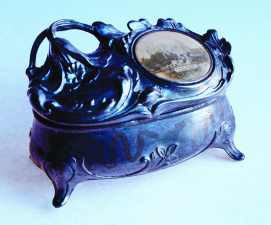 |
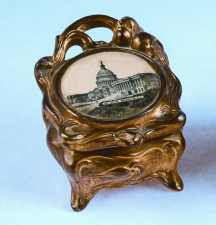 |
Jennings Brothers;
offset halftone printed image;
"Heart Island", Canada
|
Weidlich Brothers Mfg Co 332;
offset halftone printed image
|
About the same time, a jewelry and kindred wares
industry was fast developing in Germany and, at the end
of the 19th century, Pforzheim was the primary city for
their manufacture. By 1907 there were hundreds of
factories employing almost half the population of the
city. And by 1912, nearly 29,000 people worked in the
jewelry industry. So, German manufacturers began to
explore exporting opportunities in foreign countries,
especially the United States.
Electroplated ware was not as prominent in Germany as in
the United States. It had been replaced (to a great
extent) by the use of composition metals which were
called "white metal", "German silver", and "nickel
silver". These metals were desirable because, being cast
of the same metal throughout, they retained the same
appearance despite wear, and were "harder" than those
used in the United States. For this reason, fewer of
these German jewel boxes have broken hinges today or are
otherwise damaged. German factories kept secret their
exact composition.
Germany's export of composition metal wares of all kinds
in 1911 and 1912 was about $1.5million each year. Many
souvenir jewel boxes were exported to the United States,
and we still find them in the United States today. It is
also interesting to note the style of German jewel boxes.
Some do exhibit the Art Nouveau influence, yet the
floral motifs of others are somewhat more "stiff" or "rigid"
than the flowing asymmetrical lines one normally
associates with Nouveau.
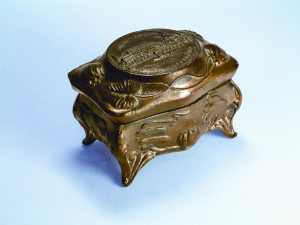 |
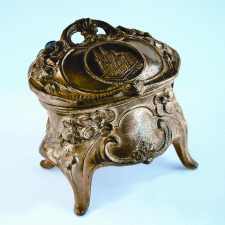 |
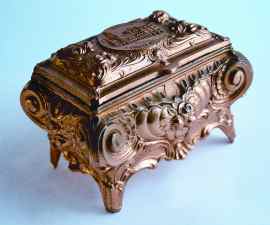 |
Germany; Nouveau
Disc impression cast as part of box
|
Germany; STYLIZED Nouveau
Disc impression cast as part of box
|
Germany; VERY stylized
Disc impression cast as part of box
|
There were several American manufacturers in the art
metal and jewelry trades that designed and produced
jewelry boxes. Kronheimer & Oldenbusch (K&O), in
particular, frequently advertised their line of souvenir
goods. But other enterprising firms such as Jennings
Brothers, Brainard & Wilson, and Weidlich Brothers also
found it to their advantage to capitalize on the
souvenir business. The marketing of souvenir jewelry
boxes became an important component of the decorative
art metal business during the early 1900’s. The
following is one example of a typical advertisement of
the time:
1906 "The ELEMENT of LOCAL PRIDE: as expressed in
SOUVENIRS
Every locality has some good reason for
self-congratulation. Some historic associations,
picturesque features, old land-marks or notable edifices
constitute appropriate subjects for local pride.
Souvenir articles representing such associations are
sure to be purchased by visitors or presented by local
residents to their guests.... All of our souvenirs
possess the double value of being very attractive and
desirable in themselves while also having the interest
of a Memento."
All these factors combined - increased travel and
discretionary spending, a desire for beautiful items not
previously available to the "average" person, and the
manufacture of "objets d’art" priced as trinkets -
encouraged travelers to purchase mementos of their
journeys inside and outside of their country. This gave
rise to the Souvenir Jewelry Box, and the sale of
jewelry boxes as souvenirs became a phenomenon.
Fortunately, we can still discover and collect examples
of these 100-year-old decorative treasures.
Joanne Wiertella - contact:
jewelboxbook@sbcglobal.net
author of "The Jewel Box Book: The Definitive
Guide to American Art Metal Jewelry Boxes
1900-1925"
208 pages - full color book - more information
available at
www.jewelboxbook.com
- 2011 -
|
|
|
|









